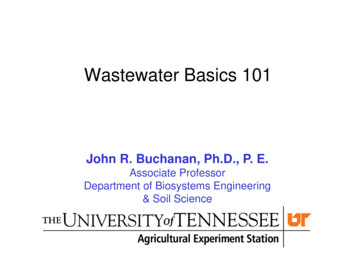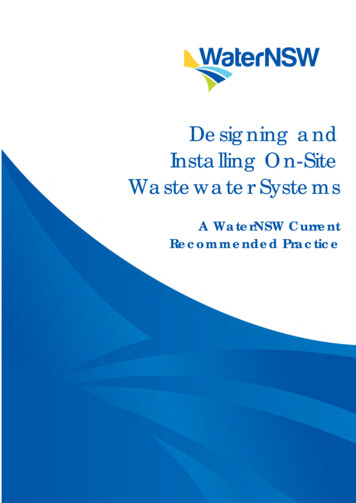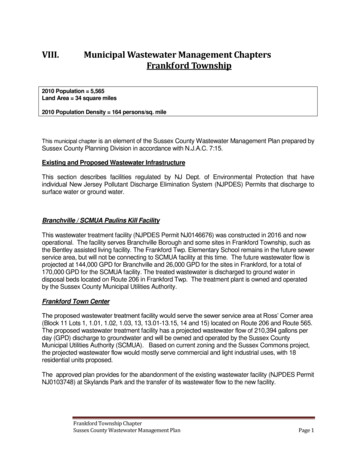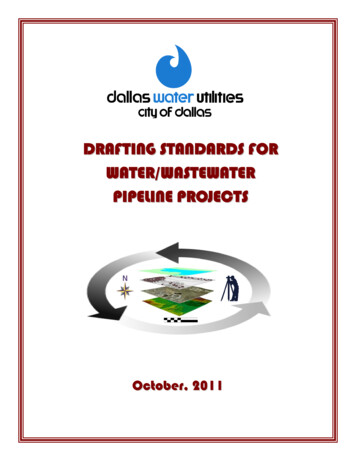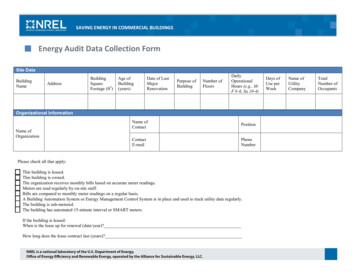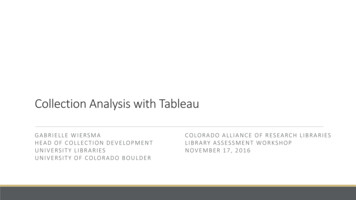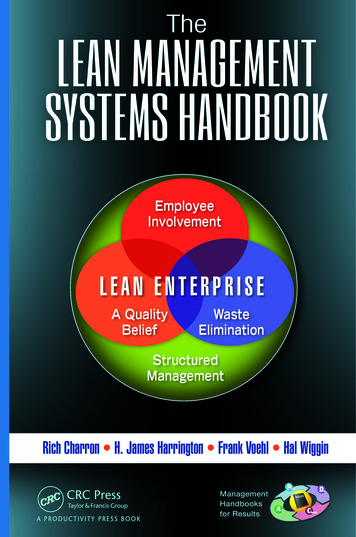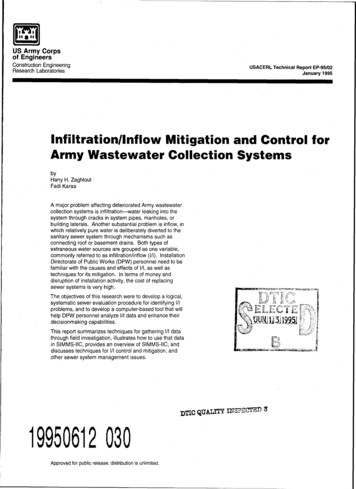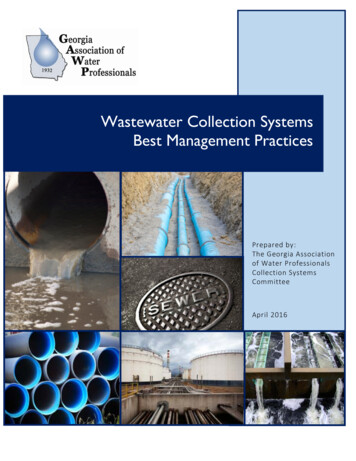
Transcription
Wastewater Collection SystemsBest Management PracticesPrepared by:The Georgia Associationof Water ProfessionalsCollection SystemsCommitteeApril 2016
WASTEWATER COLLECTION SYSTEMS BEST MANAGEMENT PRACTICESWASTEWATER COLLECTION SYSTEMSBEST MANAGEMENT PRACTICESPrepared byThe Collection Systems Committee of theGeorgia Association of Water Professionals1655 Enterprise WayMarietta, GA 30067AUGUST 2015Prepared by the Collection Systems Committee August 2015i
WASTEWATER COLLECTION SYSTEMS BEST MANAGEMENT PRACTICESTable of ContentsAcronymsiiGeorgia Association of Water ion 1Benefits of Implementing Best Management Practices1-1Section 2Collection System Mapping2-1Section 3Hydraulic Model3-1Section 4Flow and Rainfall Monitoring4-1Section 5FOG Management Program5-1Section 6Collection System Maintenance Program6-1Section 7Sewer System Condition Assessment and Rehabilitation Program7-1Section 8Contingency and Emergency Response Plan8-1BibliographyAPPENDICESAppendix A Sewer Mapping Program ProceduresAppendix BFlow Monitoring Program ProceduresAppendix CFOG Program ProceduresAppendix D Collection System Maintenance Program ProceduresPrepared by the Collection Systems Committee August 2015i
WASTEWATER COLLECTION SYSTEMS BEST MANAGEMENT PRACTICESAcronymsARVAir Release ValveBMPBest Management PracticesCCTVClosed Circuit TelevisionCERPContingency and Emergency Response PlanCICompliance InspectorCIPCapital Improvement Program or Capital Improvement PlanCMMSComputerized Maintenance Management SystemCMOMCapacity, Management, Operations, and MaintenanceCSCCollection System CommitteeCSMPCollection System Maintenance ProgramCWAClean Water ActDEDischarge EntitiesDODissolved Oxygenft/secfeet per secondFOGFats, Oil, and GreaseFSEFood Service EstablishmentGA DNRGeorgia Department of Natural ResourcesGAWPGeorgia Association of Water ProfessionalsGA EPDGeorgia Environmental Protection DivisionGISGeographical Information SystemGPMGallon per minuteGWEFGeorgia Water Environment FederationI/IInflow and InfiltrationKPIKey Performance IndicatorsNPDESNational Pollutant Discharge Elimination SystemPrepared by the Collection Systems Committee August 2015ii
WASTEWATER COLLECTION SYSTEMS BEST MANAGEMENT PRACTICESO&MOperations and MaintenancePOTWPublicly Owned Treatment WorksQA/QCQuality Assurance/Quality ControlRCPReinforced Concrete PipeRDI/IRainfall Derived Infiltration/InflowROWRights of WayRTURemote Terminal UnitSCARPSewer Condition Assessment and Rehabilitation ProgramSECAPSewer Evaluation and Capacity Assurance PlanningSRService RequestSSESSanitary Sewer Evaluation StudySSOsSanitary Sewer OverflowUSEPAUnited States Environmental Protection AgencyWCTSWastewater Collection and Transmission SystemWEFWater Environment FederationWOWork OrderPrepared by the Collection Systems Committee August 2015iii
WASTEWATER COLLECTION SYSTEMS BEST MANAGEMENT PRACTICESGeorgia Association of Water ProfessionalsFounded in 1932, the Georgia Association of Water Professionals (GAWP) is a not-for-profittechnical and educational organization and has been a Member Association of the WaterEnvironment Federation (WEF) since inception. GAWP has individual and corporate membersfrom varied disciplines who work toward preservation and enhancement of Georgia’s waterenvironment. GAWP conducts four conferences each year in Georgia and has more than 25active committees addressing various water-related issues that impact Georgia’s communities.For information on membership, publications, and conferences, contact:Georgia Association of Water Professionals1655 Enterprise WayMarietta, GA 30067USA(770) 618-8690www.gawp.orgImportant NoticeThe material presented in this publication has been prepared in accordance with generallyrecognized engineering principles and practices and is for general information only. However,the material only should be used after securing competent advice with respect to its suitabilityfor your utility and application. It is your responsibility to ensure that the information you useis accurate and appropriate to your use. GAWP makes no representation of warranty of anykind, whether expressed or implied, concerning the accuracy, product, or process discussed inthis publication and assumes no liability for consequences resulting from the use of theinformation included here. Anyone using this information assumes all liability arising from suchuse.The contents of this publication are not intended to be a standard of GAWP and are notintended for use as a reference in purchase specifications, contracts, regulations, statutes, orany other legal document.No reference made in this publication to any specific method, product, process, or serviceconstitutes or implies an endorsement, recommendation, or warranty thereof by GAWP.Prepared by the Collection Systems Committee August 2015iv
WASTEWATER COLLECTION SYSTEMS BEST MANAGEMENT PRACTICESDisclaimerIt is very important to understand several assumptions when using the Wastewater CollectionSystems Best Management Practices manual: The practices described are generalized and one size doesn’t fit all. Utilities in Georgia takemany different organizational forms, not only in the service types they provide (water,wastewater, and/or stormwater), but also in their jurisdictions and forms of governance.Parts of the process may apply to your utility, other parts may not. The Committee’s intentis to offer a buffet of best management practices that can be modified by a utility to fit itsspecific needs and requirements, so please feel free to pick and choose the ones applicableto your system.Nothing in this manual should be assumed to have any regulatory intent or to specify anystandards. The best management practices are offered for information only, with the hopeof improving the practice and efficacy of wastewater collection systems.Neither the Georgia Association of Water Professionals nor the Collections Committee orany of its members is liable for use or misuse of the Wastewater Collection Systems BestManagement Practices manual.The Wastewater Collection Systems Best Management Practices manual is not copyrighted,but if quoting, users agree to credit and give reference to the Georgia Association of WaterProfessionals.Prepared by the Collection Systems Committee August 2015v
WASTEWATER COLLECTION SYSTEMS BEST MANAGEMENT PRACTICESAcknowledgementsCompletion of a guidance document requires significant effort and expertise, not only fromthose who constructed the text, but also those who reviewed the document and providedinvaluable guidance. It is with appreciation that the following Georgia Water EnvironmentFederation Collection Systems Committee members are acknowledged for volunteering theirtime and making key contributions to this document.CSC MembersErnest Earn, Cobb County Water SystemHatem El-Sayegh, Barge, Waggoner, Sumner & CannonScott Helfrich, ADS EnvironmentalMary Beth Jacques, CH2MHeather Veal, Macon Water AuthorityGeorge D. Barnes, JAT ConsultingNicole Wein, Tetra Tech, Inc,Robin Rosen, AGK ResourcesRob Bacarro, Brown & CaldwellTroy Norton, Cobb County Water SystemMelissa Surber, ADS EnvironmentalWill Hackett, ARCADISKieu-Anh Tran, Q Solutions, Inc.Prepared by the Collection Systems Committee August 2015vi
WASTEWATER COLLECTION SYSTEMS BEST MANAGEMENT PRACTICESIntroductionWastewater collection systems are one of the major assets for which municipal utilities areresponsible. Proper management, operation, and maintenance of these assets will extend theuseful life, provide adequate capacity, reduce annual maintenance costs, and reducecontrollable overflows.The purpose of this document is to provide general guidance for municipal utilities to developand implement best management practices (BMPs) for management of wastewater collectionsystems that will include the following: Sewer MappingHydraulic ModelFlow and Rainfall MonitoringFats, Oil, and Grease (FOG) ProgramCollection System Maintenance ProgramSewer System Condition Assessment and Rehabilitation ProgramContingency and Emergency Response PlanUtilities that have been required to develop a Capacity, Management Operations andMaintenance (CMOM) Program to comply with state and/or federal Consent Decrees orConsent Agreements will be able to utilize this document to develop and implement therequired CMOM Program.This document was prepared by the Collection Systems Committee (CSC) of the GeorgiaAssociation of Water Professionals (GAWP) under the guidance of CSC members with variedperspectives and experience with collection system and CMOM Programs. The documentunderwent thorough technical review by the committee members (including utilityrepresentatives) who volunteered to provide input.To enhance the value of this document, an annotated bibliography has been included. Thebibliography contains a list of the materials and web sites used in the preparation of thisdocument, and numerous other resources that may assist wastewater utility managers as theyimplement their CMOM program.Information has been included in this guidance that may seem to be very basic or redundant.The purpose of this format is to ensure that all users of this guidance have the same level ofunderstanding on which the more advanced and complex concepts are built.Where appropriate, a range of implementation options are presented. Each utility should applyits own decision-making process as it determines which of the options most closely meet itsunique needs and situations.Prepared by the Collection Systems Committee August 2015vi
Section 1Benefits of Implementing Best ManagementPractices
WASTEWATER COLLECTION SYSTEMS BEST MANAGEMENT PRACTICESSection 1: Benefits of Implementing Best ManagementPracticesCapacity, Management, Operations, and Maintenance (CMOM) programs are often associatedby wastewater utilities with state of Georgia or federal Consent Decrees. Although the termCMOM and its associated requirements were developed by EPA, Region 4, most of thewastewater collection system operation and maintenance provisions, outlined in the EPACMOM requirements, are similar to standard practices and procedures that well-managedutilities in Georgia had developed and followed prior to the EPA requirement.These utilities have long recognized the importance and benefits of an effective wastewatercollection system operation and maintenance (O&M) program and have taken the stepsnecessary to develop, implement and update the programs.Some of the many benefits of establishing Best Management Practices or a CMOM programinclude: Preventing sanitary sewer overflows (SSOs) and maintaining a clean environment.Ensuring adequate capacity for peak flows and growth opportunities through sewerextensions.Protection of public health.Avoiding basement backups in your communities.Protecting the infrastructure investments made in pipes and pumps.An overall more efficient, better run collection system.Regardless of the name given to O&M programs, it is essential to the effective operation of autility to have a program that will: Provide effective and continuous management, operation, and maintenance, as well asensuring adequate capacity and rehabilitation when necessary.Establish performance goals, and implement activities to meet the goals.Investigate capacity constrained areas of the collection system.Proactively prevent SSOs.Establish information collection and management practices to track how the elements ofthe O&M program are meeting performance goals, and whether overall system efficiency isimproving.Maintain the value of the utility’s investment in the collection, distribution, and treatmentsystems.Prepared by the Collection Systems Committee August 20151-1
WASTEWATER COLLECTION SYSTEMS BEST MANAGEMENT PRACTICESThe development and implementation of comprehensive Best Management Practices or aCMOM program for its sewer system would provide the following benefits to the utility: Reduced operation, maintenance, and capital costs.Minimize the possibility of SSOs.An immediate response plan for quick mitigation of an SSO.Prioritize required sewer system repairs, rehabilitation, and replacements that need to beaddressed via short-term and long-term solutions.SSO reporting procedures that ensure proper reporting and posting of SSOs that occur fromthe utility’s sewer system, in accordance with GA EPD’s rules and regulations.Prepared by the Collection Systems Committee August 20151-2
Section 2Collection System Mapping
WASTEWATER COLLECTION SYSTEMS BEST MANAGEMENT PRACTICESSection 2: Collection System Mapping2.0 Purpose and GoalsA complete and accurate map of the wastewater collection system should be available and beupdated in a timely manner as new components are added or existing components are replacedor repaired.A utility’s CMOM plan should include a complete and accurate wastewater collection systemmap, as well as a plan to maintain the map as new lines, lift/pump stations, or force mains areadded or existing lines, lift/pump stations, or force mains are replaced or repaired. All lines(public and private) located within the utility’s service area should be included. Private linesshould be designated to identify private responsibilities for maintenance and should includecontact information, which should be confirmed and updated annually. New lines and repaired,relocated, and replaced lines should be incorporated into the map.The accuracy, completeness, and availability of maps of the wastewater collection system arecritical to the success of capacity assessment and management, operation, and maintenanceactivities of the collection system. It should be noted that while computerized maps are notrequired for an effective CMOM Program, GIS programs have made the mapping and mapupdating process for wastewater collection systems considerably more efficient. Whether awastewater utility utilizes a GIS, or relies on paper maps, the following information should beincluded to have an effective CMOM Program. Main, trunk, and interceptor sewersBuilding and house lateralsManholesCleanoutsForce mainsLift stations/pump stationsFlow monitors and rain gaugesService area boundariesOther landmarks (roads, water bodies, etc.)In addition, collection system maps should have a permanent numbering system that uniquelyidentifies all manholes and sewer cleanouts and references the property served with itscleanout. Sewer line attributes should include pipe diameter, material, length, installation date,condition, rehabilitation method, rehabilitation date, invert elevations, slope, and flowdirection. Manhole attributes should include size, shape, type, depth, age, condition, andmaterials. (When paper maps are used, a separate spreadsheet or other system should be usedto maintain sewer line and manhole attribute information). Maps should include access andPrepared by the Collection Systems Committee August 20152-1
WASTEWATER COLLECTION SYSTEMS BEST MANAGEMENT PRACTICESoverflow points, easements and property lines, and always reference the date the map wasdrafted and date of last revision. Separate detailed local maps should be indexed to an overallmap of the system. GIS programs should be capable of accepting information from amanagement program such as a Computerized Maintenance Management System (CMMS).Specific procedures should be in place for correction of errors and updating maps.Maps should be available to field personnel, who should be properly trained to recognizeddiscrepancies between field conditions and map data, and to record changes necessary tocorrect the mapping system.Problems in the collection system, such as those due to grease or industrial discharges,hydraulic bottlenecks, areas of poor design (e.g., insufficient slope), and excessive infiltration,as well as the number of stoppages experienced per mile of sewer pipe, should be noted onmaps or other documents. SSOs should also be mapped or recorded on other documents.Service area boundaries and dimensions of landmarks, such as surface streets, street addresses,surface water bodies, political boundaries, sewersheds and sewershed basins, property lines,utility easements, and rights-of-ways, should be included on the maps.2.1 PipesPipe data will typically be available from historical maps, such as collection system atlases andrecord drawings. Physical inspections may be used to confirm and update the location,diameter, and pipe material.Mapping or other types of documents for pipes should include: DiameterLengthMaterialAgeSlopeFlow directionConditionDate and type of last rehabilitationForce, gravity, and/or aerial mainsPipe invert levelsPipe roughnessShapeService lateralsCleanoutsPrepared by the Collection Systems Committee August 20152-2
WASTEWATER COLLECTION SYSTEMS BEST MANAGEMENT PRACTICESAs pipe condition and other information is obtained from condition assessments using polecameras, CCTV, or pipe lamping, maps and other documents should be updated to ensure thatdata is current.2.2 ManholesThe location of all manholes should be verified by physical inspection. Additional manhole datamay also be available from historical maps, such as collection system atlases and recorddrawings. The physical inspections should document the physical condition of the sanitarysewer manholes and identify possible sources of infiltration/inflow (I/I). Such data can also beused to establish and prioritize manhole maintenance and rehabilitation needs. It is critical tohave a standardized manhole inspection process that can be incorporated into routinemaintenance activities. The standardization of manhole inspection and rehabilitation processesgreatly reduces the effort required to verify the condition data for each manhole for properrehabilitation. Mapping of manholes should include: Location (e.g., coordinates)ShapeInside diameterTypeDepthAgeMaterial of constructionCondition including:o Rootso Evidence of infiltrationo Active infiltrationo Debris in manholeo Evidence of surchargingo GreaseDate and type of rehabilitationManhole ring/cover elevationInvert elevations of inlet/outlet sewersAccessibilityPhotographsPrepared by the Collection Systems Committee August 20152-3
WASTEWATER COLLECTION SYSTEMS BEST MANAGEMENT PRACTICES2.3 Lift/Pump StationsThe location of all lift/pump stations should be shown and verified by physical inspection. Someof the required lift/pump station information may be obtained from record drawings andduring routine inspections and maintenance of the lift/pump station. Regardless of the type ofmapping technology that is used, the following information should be maintained: LocationNumber, types, and sizes of pumps and motorsTotal capacity (all pumps operational)Stand-by powerTelemetry systemFirm capacity of the stationSize of the wet wellInlet and discharge elevationsForce main size, material, and locationStructures that restrict flowFlow monitorsVariable speed pumping installationsAutomated control systemsManually controlled pumps2.4 Force MainsForce mains are often the forgotten piece of the collection system. O&M responsibilities mayfall upon the lift/pump station crews that are ill-equipped to work on pipe lines. Force mainmapping may be more critical than gravity lines because when they fail, a significant SSO mayoccur. Mapping should include a thorough condition assessment of Air Release Valves (ARV).ARVs should receive routine inspections along with the lift/pump stations to identify problemsearly before they lead to internal corrosion of the force mains from H2S gasses. Force main materialSizeForce main ageARV locationARV typeARV agePrepared by the Collection Systems Committee August 20152-4
WASTEWATER COLLECTION SYSTEMS BEST MANAGEMENT PRACTICES2.5 Program Resources2.5.1 StaffStaffing for support of the Collection System Mapping Program should be based on the size ofthe wastewater collection system, mapping system, and existing level of mapping. Thefollowing types of staff are typical for maintaining a collection system mapping program: System Mapping ManagerGIS Technician and/or AutoCAD TechnicianField Staff/Surveyors2.5.2 EquipmentEquipment required for supporting the Collection System Mapping Program should be based onthe type of system mapping used by the utility. Equipment typically required is shown below.Field Equipment 2.6Laptop computersSurvey-grade GPS equipmentTraditional survey equipmentPole cameras and lamping equipmentVideo equipmentDigital camerasLeveling rods and tapesSafety equipment: hard hats, safetyglasses, rubber gloves, vests, and steelcapped bootsOffice Equipment and Software ComputersPrinters and plottersServersArcGIS Asset management softwareCMMSCollection System Mapping Program Performance MeasuresPerformance measures are important management tools that allow for continuousmeasurement and evaluation of program activities. Performance measures are designed tocollect information that enable a utility to determine if established goals and level of service arebeing met and if not, what activities need to be adjusted to meet program goals.Suggested Key Performance Indicators (KPIs) are shown in Table 1-2. Desired results should beestablished by the utility.Prepared by the Collection Systems Committee August 20152-5
WASTEWATER COLLECTION SYSTEMS BEST MANAGEMENT PRACTICESKPIFormula# of SewerMains MappedValue% Sewer MainsMapped# Linear FeetMapped / TotalLinear Feet inSystem# of manholesmapped/Total #of manholesValue% ManholesMappedNumber ofRecordDrawingsReceivedNumber ofRecordDrawingsMappedNumber ofRecordDrawingsBacklogged100% of SystemMapped andInventoriedValueValue100 x (feet ofsewers,# of MHsor force mainsmapped/totalfeet of sewers, #of MHS or totalfeet of forcemains). 100 x #of PSs/total # ofPSsTable 1-2DefinitionNumber of linesmapped/updated peryearPercentage of systemmapped in reportperiodDesired ResultData IntervalAnnualAnnualPercentage ofmanholes mapped inreport periodNumber of newsystems received inreport periodAnnualNumber of newsystems located andmapped in reportperiodNumber of as builtsneeding location andmappedAnnualAll manholes, sewers,force mains and PSmapped andinventoriedPrepared by the Collection Systems Committee August 2015Annual0AnnualAccurate mapsand inventory ofentire collectionandtransmissionsystem2-6
WASTEWATER COLLECTION SYSTEMS BEST MANAGEMENT PRACTICES2.7 Program ProceduresProcedures for the System Mapping Program should be developed to provide consistency andaccuracy in the data results.Sample Collection Mapping Program ProceduresSCHEDULESchedule based on areas identified by Program Manager of mapping program or other designatedpersonnel.ACTIVITY DESCRIPTIONProcedure defines mapping activities for field crews and data management activities for GIS specialists.ACTIVITY GOALSTo accurately identify assets in the field using GPS equipment and upload data into GIS database.LABORMATERIAL and EQUIPMENTCodeClassificationCodeDescription CMOM ProgramCoordinatorGIS ManagerGIS SpecialistsUtility personnelthat conduct fieldsurveysContract personnelthat conduct fieldsurveysContract personnelwho perform datamanagementSafety Checklist Safety Program PlanTraffic Safety Requirements SAFETY ANALYSISPotential Hazards Prepared by the Collection Systems Committee August 2015Laptop computersTraditional andsurvey-grade GPSequipmentManhole etchingequipmentDigital camerasLeveling rods andtapesSafety equipment:hard hat, safetyglasses, rubbergloves, vests andsteel-capped bootsInfectious DiseasesSlip, Trip, and FallSnakes, Pests, InsectsConfined Space Entry (not applicable, fieldcrews are not entering confined space)TrafficVehicle OperationElectrical Hazards (Electrical Safety)Lifting2-7
WASTEWATER COLLECTION SYSTEMS BEST MANAGEMENT PRACTICESMapping Procedures for Manholes and CleanoutsField personnel (utility or contractor) gather location information in the field and transmit thedata in digital and/or hard-copy format to the utility GIS manager for integration into existingsystems. Deliverables for each basin /sub-basin should include digital photos of manholes, GIScompatible database, map books, and recommendations for sewer lines to be surveyed. Utilitystaff should be involved in quality control and integrating the information into the existing GIS,CMMS, and other systems.(1)(2)(3)(4)(5)(6)Field maps are created from the existing GIS database both to assist field crews inlocating sewer features and to be marked up where errors are found during fieldverification. Inspection crews are sent out first to collect attributes. Separate surveycrews follow to collect GPS locations.Inspection crews collect attributes information and record the data. Field maps arecorrected with red-line edits. Digital photos are taken of manholes. The orientationof all incoming and outgoing pipes is recorded relative to north.Working one basin/sub-basin at a time, the field personnel perform the initial datacollection and a quality review.The utility staff complete quality checks and return questionable data to the fieldpersonnel for verification. The utility issues internal work orders to locate anymanholes noted as buried or not located.Survey crews receive a list of manholes and the corrected field maps from theinspection crews. Control points are established, and the survey crews follow thecorrected maps to collect horizontal and vertical coordinates for each manhole andcleanout with GPS or conventional survey equipment.The new asset information should be incorporated into the utility’s appropriate datamanagement system and hydraulic model. The information should include surveycoordinates and elevations of manholes, incoming and outgoing pipes, and digitalphotos.Mapping Procedures for Sewer Lift Stations(1)(2)Field personnel perform survey of lift station wet well, vault chambers, standbygenerators, fencing, and stormwater structures. Measurements are made of wetwell dimensions and the elevations of level controls. All data is recorded on the LiftStation/Pump Station Inspection Form or in an electronic database.Survey crews collect horizontal coordinates for the corners of structures, includingbuildings and fences, and elevations of the top of structures.Prepared by the Collection Systems Committee August 20152-8
Section 3Hydraulic Model
WASTEWATER COLLECTION SYSTEMS BEST MANAGEMENT PRACTICESSection 3: Hydraulic Model3.0 Purpose and GoalsModeling the system will provide an understanding of the hydraulic behavior of the wastewatercollection and transmission system (WCTS), which will assist utilities in making informeddecisions concerning strategic planning and capital improvements required to meet theperformance goals of the utility.The Hydraulic Model should include processes to determine system capacity and itsrelationship with wet weather and to identify, characterize, and address hydraulic deficiencies.The purpose of the Hydraulic Model is to: Determine if adequate capacity exists for continued collection of wastewater for existingand projected future flows during both dry and wet weather conditions.Assist the utility in meeting level of service performance objectives expected by customers.Identify capital and operational improvements required to respond to and managedevelopment and economic growth.3.1 Resources3.1.1 StaffStaffing for support of the Hydraulic Model Program should be based on the size of thewastewater collection system and existing level of hydraulic modeling. The following types ofstaff are typical for maintaining a hydraulic modeling program: Hydraulic Modeling ManagerHydraulic Modeler(s)Engineering Consultant Support (as needed)3.2 Activities3.2.1 OverviewThe Hydraulic Model should include the following components: Description of the software used to develop the model.Types and sources of data used to develop the model (GIS data, record drawings,operational data, sewer system maps, flow and rainfall monitoring data, and sewer systeminspection records).The approach used to develop separate models representing each sewershed and how theywill be integrated into one hydraulic system model.Description of how the model will be used to predict:Prepared by the Collection Systems Committee August 20153-1
WASTEWATER COLLECTION SYSTEMS BEST MANAGEMENT PRACTICESThe rate of wastewater flow and capacity of major gravity sewer lines including peakflows during wet weather conditions.o The likelihood and location of capacity-related SSOs.o The hydraulic pressure and capacity of force mains and pumping stations.o The flow capacity of each lift station.o The available capacity in sanitary sewers to receive flows from proposed developments.o Capital improvements, including sewer rehabilitation and relief sewer construction,required to meet current and projected future flow conditions.Description of how the model will be calibrated using existing flow, rainfall, and inspectionand operational data.Description of how the volume and rate of wastewater flow, groundwater infiltration, andRainfall Derived Infiltration/Inflow (RDI/I) was projected for each sewershed andincorporated into the model.RDI/I hydrographs for sewersheds and sewer basins (the hydrographs should be developedusing historical flow data).Description of how the model will be used to determine availability of capacity prior topermitting increases of wastewater flows from existing sewer service connections and fromproposed new development.Specific definitions and parameters for determining the adequacy of collection,conveyance, and treatment capacity.o 3.2.2 Hydraulic Modeling SoftwareA sewer system hydraulic model is a mathematical model of a fluid introduced into awastewater sewer at various rates and pressures. It is used to analyze system hydraulicbehavior under variable conditions. In general, commercial sewer modeli
CMMS Computerized Maintenance Management System . CMOM Capacity, Management, Operations, and Maintenance . CSC Collection System Committee . CSMP Collection System Maintenance Program . CWA Clean Water Act . DE Discharge Entities . DO Dissolved Oxygen . ft/sec feet per second . FOG Fats, Oil, and
